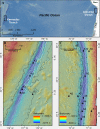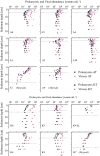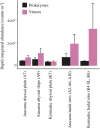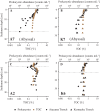Spatial variability of prokaryotic and viral abundances in the Kermadec and Atacama Trench regions
- PMID: 34239169
- PMCID: PMC8248377
- DOI: 10.1002/lno.11711
Spatial variability of prokaryotic and viral abundances in the Kermadec and Atacama Trench regions
Abstract
Hadal trenches represent the deepest part of the ocean and are dynamic depocenters with intensified prokaryotic activity. Here, we explored the distribution and drivers of prokaryotic and viral abundance from the ocean surface and 40 cm into sediments in two hadal trench regions with contrasting surface productivity. In the water column, prokaryotic and viral abundance decreased with water depth before reaching a rather stable level at ~ 4000 m depth at both trench systems, while virus to prokaryote ratios were increasing with depth, presumably reflecting the declining availability of organic material. Prokaryotic and viral abundances in sediments were lower at the adjacent abyssal sites than at the hadal sites and declined exponentially with sediment depth, closely tracking the attenuation of total organic carbon (TOC) content. In contrast, hadal sediment exhibited erratic depth profiles of prokaryotes and viruses with many subsurface peaks. The prokaryotic abundance correlated well to extensive fluctuations in TOC content at centimeter scale, which were likely caused by recurring mass wasting events. Yet while prokaryotic and viral abundances cross correlated well in the abyssal sediments, there was no clear correlation in the hadal sites. The results suggested that dynamic depositional conditions and higher substrate availability result in a high spatial heterogeneity in viral and prokaryotic abundances in hadal sediments in comparison to more stable abyssal settings. We argue that these conditions enhance the relatively importance of viruses for prokaryotic mortality and carbon recycling in hadal settings.
© 2021 The Authors. Limnology and Oceanography published by Wiley Periodicals LLC on behalf of Association for the Sciences of Limnology and Oceanography.
Conflict of interest statement
None declared.
Figures









References
-
- Angel, M. V. 1982. Ocean trench conservation. Environmentalist 2: 1–17. doi:10.1007/BF02340472 - DOI
-
- Azam, F. 1998. Microbial control of oceanic carbon flux: The plot thickens. Science 280: 694–696. doi:10.1126/science.280.5364.694 - DOI
-
- Bendtsen, J. , Lundsgaard C., Middelboe M., and Archer D.. 2002. Influence of bacterial uptake on deep‐ocean dissolved organic carbon. Global Biogeochem. Cycles 16: 74‐1–74‐12. doi:10.1029/2002GB001947 - DOI
-
- Blankenship, L. E. , Yayanos A. A., Cadien D. B., and Levin L. A.. 2006. Vertical zonation patterns of scavenging amphipods from the Hadal zone of the Tonga and Kermadec Trenches. Deep‐Sea Res. Part I Oceanogr. Res. Pap. 53: 48–61. doi:10.1016/j.dsr.2005.09.006 - DOI
LinkOut - more resources
Full Text Sources
